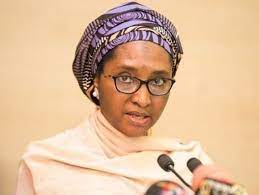The Federal Government has projected a rise to 4.2 percent of the country’s Gross Domestic Product (GDP) in 2022.
Mrs Zainab Ahmed, Minister of Finance, Budget and National Planning said this at the Public Consultation on the Draft 2022 to 2024 Medium Term Fiscal Framework and Fiscal Strategy Paper (MTFF/FSP) on Thursday.
Ahmed said the GDP projected in 2021, to close at three per cent, had been adjusted downwards to close at 2.5 percent.
“In 2022, we are expecting an uptake to 4.2 percent, then a dip to 2.3 per cent in 2023 and up to 3.3 per cent in 2024.”
The minister further said the Nominal GDP projected for 2022 was N184.38 trillion up from N168.6 trillion in 2021, and then to N201 trillion in 2023 and N222 trillion in 2024.
She also said the inflation rate was expected to drop slightly to 13 per cent in 2022 from 15 per cent in 2021.
She noted that the increase in inflation was due to the exchange rate.
“Inflation rate, which was planned for 11.95 percent in 2021, has been reflected in reality because the exchange rate is high. The average we have so far is 15 percent.
“We are expecting 2022 to go down slightly to 13 percent, then 11 percent in 2023 and 10 percent in 2024.”
She, however, said the Federal Government had put the Nigerian Autonomous Foreign Exchange Rate Fixing (NAFEX) rate of N410.15 to one US dollar for 2022 to 2024.
“The exchange rate of the Naira to the dollar, which was N379 in the 2021 budget, has been adjusted to the NAFEX rate of N410.15 to one US dollar.
“We are assuming, for now, the same rate for 2022, 2023 and 2024.”
Furthermore, Ahmed took an overview of the federation and fiscal outcomes for the Federation and Value Added Tax (VAT) Pool Accounts Distributable for January to May.
She said the amount available for distribution from the Federation Account was N2.78 trillion.
“Of this amount, the Federal Government received N998.57 billion, while the states and Local Governments received N506.59 billion and N390.48 billion respectively from the Main Pool Account.
“Federal, state and local governments received N132.70 billion, N442.33 billion and N309.63 billion respectively from the VAT Pool Account.”
Also, the minister said the gross oil and gas revenue was projected at N5.19 trillion for January to May.
“As of May, N1.49 trillion was realised out of the prorated sum of N2.16 trillion. This represents 69 per cent performance.
“Oil and gas deductions were N194.31 billion (or 45.8 percent) more than the budget.
“This is mainly attributable to petroleum subsidy costs which was not provided for in the 2021 Budget.
“After netting out deductions (including 13 percent derivation) net oil and gas revenue inflows to the Federation Account amounted to N872.16 billion.”
She noted that the inflow was N864.20 billion or 49.8 per cent less than the projection as of May.
Giving an update on the revenue performance of 2021 budget implementation for January to May, Ahmed said the Federal Government’s retained revenue was N1.84 trillion, 67 percent of pro rata target.
She said the share of oil revenues was N289.61 billion, which represented 50 percent performance.
She also added that non-oil tax revenues totalled N618.76 trillion, 99.7 percent of pro rata.
“Companies Income Tax (CIT) and VAT collections were ahead of the budget targets with N290.90 billion and N123.85 billion, representing 102 per cent and 125 per cent respectively of the pro rata targets for the period.
“Customs collections was N204.0 billion (86 per cent of target).
She said other revenues amounted to N762.70 billion, of which independent revenues were N487.01 billion.
On the expenditure side, the minister said N4.86 trillion, representing 92.7 per cent of the prorated budget had been spent.
“This excludes GOEs’ and project-tied debt expenditures.”
She noted that of the expenditure, N1.80 trillion was for debt service representing 37 percent of Federal Government’s expenditure and N1.50 trillion for Personnel costs, including Pensions, representing 31 percent of Federal Government’s revenues.
The minister further said that as at May, N973.13 billion had been released for capital expenditure.

